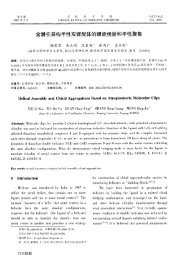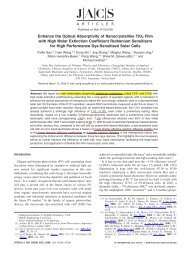Coexistence of chiral hydrophilic and achiral hydrophobic channels ...
Coexistence of chiral hydrophilic and achiral hydrophobic channels ...
Coexistence of chiral hydrophilic and achiral hydrophobic channels ...
Create successful ePaper yourself
Turn your PDF publications into a flip-book with our unique Google optimized e-Paper software.
View OnlineCOMMUNICATIONwww.rsc.org/chemcomm | ChemComm<strong>Coexistence</strong> <strong>of</strong> <strong>chiral</strong> <strong>hydrophilic</strong> <strong>and</strong> a<strong>chiral</strong> <strong>hydrophobic</strong> <strong>channels</strong> inone multi-helical-array metal–organic framework incorporating helicalwater cluster chains{Shuangquan Zang, Yang Su, Chunying Duan, Yizhi Li, Huizhen Zhu <strong>and</strong> Qingjin Meng*Received (in Cambridge, UK) 29th August 2006, Accepted 22nd September 2006First published as an Advance Article on the web 19th October 2006DOI: 10.1039/b611994hDownloaded on 04 December 2010Published on 19 October 2006 on http://pubs.rsc.org | doi:10.1039/B611994HA novel host–guest metal–organic compound with both <strong>chiral</strong><strong>hydrophilic</strong> <strong>and</strong> a<strong>chiral</strong> <strong>hydrophobic</strong> <strong>channels</strong> has beenobtained through the reaction <strong>of</strong> Cd(II) ion <strong>and</strong> a versatileasymmetrical lig<strong>and</strong> <strong>of</strong> H 4 bptc (H 4 bptc = 1,19-biphenyl-2,29,3,39-tetracarboxylic acid) based on hydro(solvo)thermalreactions.Helicity is a topological motif that is highly attractive not onlybecause <strong>of</strong> its fascinating structure but also for its realistic <strong>and</strong>potential applications in many fields. 1–3 There is no doubt that thesearch for new structural motifs for helical architectures has beenan intensive research area to date. 4 Though the basic features <strong>of</strong>the design necessary to assemble discrete helices or low dimensionalhelical coordination polymers are now fairly well established,the design <strong>and</strong> control <strong>of</strong> the assembly <strong>of</strong> the helical unitinto a multi-helical-array still remains a challenge. 5Meanwhile, metal–organic frameworks with high porosity haveattracted a great deal <strong>of</strong> attention, 6 especially the helical tubularstructure with <strong>chiral</strong> porosities that are capable <strong>of</strong> recognizingspecial guests. 7 While most <strong>of</strong> the effort has so far focused on theassembly <strong>of</strong> the porous metal–organic open frameworks with large<strong>and</strong> identical cavities for molecular absorption <strong>and</strong> stabilization,one framework with two distinct cavities or <strong>channels</strong> remainslargely unexplored <strong>and</strong> difficult to construct, notwithst<strong>and</strong>ing theinteresting phenomena which have been found in these rareexamples. 8Here we report a novel d 10 metal–organic coordination polymer[Cd 4 (bptc) 2 (bpy)(H 2 O) 8 ]?5.5H 2 O (1) (H 4 bptc = 1,19-biphenyl-2,29,3,39-tetracarboxylic acid) having large <strong>hydrophilic</strong> helical<strong>channels</strong> with alternately arranged <strong>chiral</strong>ity <strong>and</strong> small <strong>hydrophobic</strong>a<strong>chiral</strong> micro<strong>channels</strong> <strong>of</strong> two initially interwoven double-str<strong>and</strong>edhelices. Meanwhile, each <strong>hydrophilic</strong> helical channel acting as ahost incorporates a helical stream <strong>of</strong> water clusters.Needle shaped crystals <strong>of</strong> 1 were obtained by the hydrothermalreaction <strong>of</strong> Cd(NO 3 ) 2 ?4H 2 O, H 4 bptc <strong>and</strong> bpy in water in thepresence <strong>of</strong> triethylamine at 120 uC for five days.{ The X-raycrystal structure analyses§ reveal that 1 crystallizes in the highsymmetry tetragonal space group I4 1 /a. The asymmetric unit <strong>of</strong> 1(Fig. 1) contains four crystallographically independent Cd 2+ ions,two unique bptc lig<strong>and</strong>s in different coordination modes (Scheme 1Fig. 1 The asymmetric unit <strong>of</strong> 1. Solvent water molecules <strong>and</strong> hydrogenatoms are omitted for clarity. (Symmetry code: A: x, y, 21+z;B:21/4 +y,5/42 x,5/42 z;C:x, y,1+z;D:21/4 + y,3/42 x,3/4+z;E:5/42 y,1/4 + x, 9/42 z).<strong>and</strong> Fig. 1), <strong>and</strong> one 4,49-bpy molecule. The Cd1 ion (mode 1 inScheme 1) is seven-coordinate <strong>and</strong> is described as having adistorted pentagonal-bipyramidal geometry with one long axis(Cd1–O1 = 2.826 Å) (Fig. 1 <strong>and</strong> S1). The coordination geometryfor the six-coordinate Cd2 <strong>and</strong> Cd4 ions (Scheme 1) is close tooctahedral(Fig.1<strong>and</strong>S1).TheCd3ion(Scheme1,Fig.1<strong>and</strong>S1)is seven-coordinate <strong>and</strong> is described as having a pentagonalbipyramidalgeometry.A survey down the c-axis easily identifies the existence <strong>of</strong> twodistinct types <strong>of</strong> <strong>channels</strong> (Fig. 2). The small <strong>channels</strong> (diameter 9 <strong>of</strong>1.73 Å)arelocatedat(0,J, z), (0, L, z), (K, J, z)<strong>and</strong>(K, L, z)while the large <strong>channels</strong> (diameter 9 <strong>of</strong> 7.83 Å)arelocatedat(J,0,z), (J, K, z), (L, 0,z) <strong>and</strong>(L, K, z) (Fig. 2 <strong>and</strong> S2).Thefirstfeature<strong>of</strong>1 is that the small channel consists <strong>of</strong> twointerwoven double-str<strong>and</strong>ed helical chains with opposite orientations(Fig. 3a <strong>and</strong> S3). In the double-str<strong>and</strong>ed helices, chains withthe same <strong>chiral</strong>ity are interconnected through bpy moleculesCoordination Chemistry Institute, State Key Laboratory <strong>of</strong>Coordination Chemistry, School <strong>of</strong> Chemical Engineering, NanjingUniversity, Nanjing 210093, China. E-mail: Mengqj@nju.edu.cn{ Electronic supplementary information (ESI) available: Selected bonddistances <strong>and</strong> angles, hydrogen bond table, packing diagram, TG curve,<strong>and</strong> PXRD patterns. See DOI: 10.1039/b611994hScheme 1 Two different coordination modes <strong>of</strong> the bptc lig<strong>and</strong> in 1.Each <strong>of</strong> the two modes is actually <strong>chiral</strong> <strong>and</strong> has its mirror coexisting inthe crystal. (Symmetry code: A: 5/4 2 y,1/4+x,5/42 z;B:1/4+y,5/42x, 5/42 z; C:3/42 y, 1/4+x, 23/4 + z; D:x, y, 21 +z).This journal is ß The Royal Society <strong>of</strong> Chemistry 2006 Chem. Commun., 2006, 4997–4999 | 4997
View OnlineDownloaded on 04 December 2010Published on 19 October 2006 on http://pubs.rsc.org | doi:10.1039/B611994HFig. 2 The framework <strong>of</strong> 1 viewed down the c axis, showing the twodistinct types <strong>of</strong> <strong>channels</strong> in the structure <strong>of</strong> 1. Cd 2+ ions are representedby polyhedra. The small <strong>hydrophobic</strong> <strong>channels</strong> are colored red while thelarge <strong>hydrophilic</strong> <strong>channels</strong> are colored blue with surrounding arrowsrepresenting their <strong>chiral</strong>ity.coordinating to Cd1 <strong>and</strong> Cd4 (Fig. S3). The smallest repeat unit <strong>of</strong>each str<strong>and</strong> employs two bptc lig<strong>and</strong>s in mode I that are connectedthrough Cd1, Cd2 <strong>and</strong> Cd4 ions (Scheme 1 <strong>and</strong> Fig. S3). Theseparation between adjacent chains <strong>of</strong> the double-str<strong>and</strong>ed helicesis the same as the cell period c (13.523 Å) while the pitch <strong>of</strong> eachchain is 2c. Chains with opposite orientations are connectedthrough 2- <strong>and</strong> 29-carboxylate groups <strong>and</strong> interweave with eachother up <strong>and</strong> down (Fig. 3a <strong>and</strong> S3). The benzene rings <strong>of</strong> the bptclig<strong>and</strong>s are alternately trapped inside the helical <strong>channels</strong> to give<strong>hydrophobic</strong> small tubules (Fig. 2). As divinable, the water (O25)suspended in this <strong>hydrophobic</strong> channel is disordered <strong>and</strong> itsoccupancy is 50%. Four helical chains are essentially symmetryequivalents that are related by an S 4 -axis passing through them(Fig. S5 <strong>and</strong> S6 in supporting information). Therefore the smallchannel is a<strong>chiral</strong>. From our underst<strong>and</strong>ing <strong>of</strong> helical coordinationpolymers, frameworks with two interwoven double helical chainsare uncommon.In contrast to the small channel comprising only mode I, thelarge channel employs both modes I <strong>and</strong> II (Scheme 1 <strong>and</strong> Fig. S7).Mode I is connected to mode II through Cd1 <strong>and</strong> Cd4 ions t<strong>of</strong>orm a helical chain (Scheme 1 <strong>and</strong> Fig. S7). As for the largechannel, it consists <strong>of</strong> a triple-helical-str<strong>and</strong> with each str<strong>and</strong> a 4 3helical chain (Fig. 3b <strong>and</strong> Fig. S7). The separation betweenadjacent chains is c while the pitch <strong>of</strong> each chain is 3c. The <strong>chiral</strong>ity<strong>of</strong> these <strong>channels</strong> is alternately distributed <strong>and</strong> depends on thelocation where the triple-helical-str<strong>and</strong> resides—right-h<strong>and</strong>ed witha4 3 -axis at (J, 0,z) <strong>and</strong>(L, K, z), left-h<strong>and</strong>ed with a 4 1 -axis at(J, K, z) <strong>and</strong>(L, 0,z) (Fig. 2 <strong>and</strong> S2). In addition to the bpymolecules coordinating to Cd1 <strong>and</strong> Cd4, adjacent chains in triplestr<strong>and</strong>edhelices are as well connected through Cd3 ionscoordinated by the 3- <strong>and</strong> 39-carboxylate groups in mode II(Fig. S7 <strong>and</strong> S8). Wonderfully, the severely twisted bptc lig<strong>and</strong>sfurther lead to local <strong>chiral</strong>ity in every single chain, giving a quasihelicalribbon arrangement (Fig. S7 <strong>and</strong> S9). Interestingly, Cd2ions are embedded in the inner wall <strong>of</strong> the large channel bycoordinating with the 2- <strong>and</strong> 29-carboxylate groups in mode I(Fig. 2 <strong>and</strong> S10). The coordination waters pointing to the inside <strong>of</strong>the channel (four on Cd2 along with two on Cd3), acting asfunctional adornments, make the large channel remarkably<strong>hydrophilic</strong>. As a matter <strong>of</strong> fact, no metal–organic frameworkthat has both a triple-helical-str<strong>and</strong> <strong>and</strong> interweaving <strong>of</strong> twodouble-str<strong>and</strong>ed helices has been reported before.Another interesting structural feature <strong>of</strong> 1 is the helical stream <strong>of</strong>guest waters in the host <strong>hydrophilic</strong> helical <strong>channels</strong>. This helicalwater stream is made up <strong>of</strong> co-edged (O27 … O28) V-shaped waterheptamers sharing the same screw axis <strong>and</strong> keeping its <strong>chiral</strong>itywith its host channel (Table S1 <strong>and</strong> Fig. 4a, 4b). Alternatively, thishelical 1D polymer can also be regarded as two intra-hydrogenbondedhelical water chains (namely a double-str<strong>and</strong>ed helicalchain) connected to each other through inter-chain hydrogenbonds (O27 … O28) (Fig. 4c). The helical water stream is furthersupported <strong>and</strong> stabilized by maintaining hydrogen bond networksto the aqua lig<strong>and</strong>s (O20) in the wall <strong>of</strong> the <strong>hydrophilic</strong> channel,whichinturntransfersits<strong>chiral</strong>ity to the water stream inside it<strong>and</strong> hence determines the orientation <strong>of</strong> the helical water stream(Table S2, Fig. 4c <strong>and</strong> S11). In this sense, the helical tubular hostFig. 3 (a) Two interwoven double-str<strong>and</strong>ed helical chains with thereverse orientation. Two right-orientated chains are colored cyan <strong>and</strong>green while two left-orientated chains are colored magenta <strong>and</strong> pink. (b)Two adjacent large helical <strong>channels</strong> with opposite <strong>chiral</strong>ity. The triplehelicalchains are colored magenta, cyan, <strong>and</strong> green. In (a) <strong>and</strong> (b), bpymolecules <strong>and</strong> Cd3 atoms are omitted for clarity.Fig. 4 (a) V-shaped water heptamers. (b) The helical water clusterstream. Hydrogen bonds are marked as light blue broken lines. (c) Each<strong>hydrophilic</strong> <strong>chiral</strong> host helical tubular channel incorporates a guest helicalwater cluster chain with the same <strong>chiral</strong>ity. This water chain can be seen asdouble-str<strong>and</strong>ed helical water chains. Two water chains are colored pink<strong>and</strong> gold, while interchain interactions (O27 … O28) are presented as lightgreenish blue. Hydrogen atoms are omitted for clarity.4998 | Chem. Commun., 2006, 4997–4999 This journal is ß The Royal Society <strong>of</strong> Chemistry 2006
















